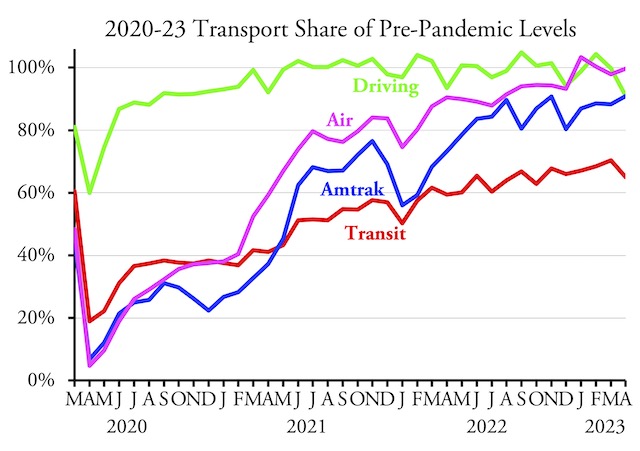Americans drove 91 percent as many miles in April 2023 as they did in the same month in 2019, according to data released by the Federal Highway Administration yesterday. Relative to before the pandemic, driving hasn’t been this low since August 2020.
See last Wednesday’s post for a discussion of transit and air travel and last Thursday’s post for a discussion of Amtrak travel.
As I pointed out last week, April 2023 had two fewer business days than April 2019. But the number of business days seems to have less of an effect on driving than on transit. After all, commuters make up at least 40 percent of transit ridership but less than 20 percent of vehicles on the road. Driving in February, which has the same number of business days each year, was 104 percent of 2019 while driving in March, which had two more business days than in 2019, was 100 percent of 2019.
Both rural and urban driving were less than in 2019. Rural driving was more than in 2019 in 11 states, while urban driving exceeded 2019 in just four states plus DC. Counting both urban and rural, April driving was greater in 2023 than 2019 only in Rhode Island, the District of Columbia, Arkansas, Louisiana, Texas, Idaho, and Montana.
One factor that may have influenced the relative decrease in driving was fuel prices. According to GasBuddy, the nationwide average price of regular gasoline rose from $3.40 near the end of March to nearly $3.70 in mid-April. For the month of April as a whole, however, it appears that prices averaged around $3.55, while March averaged around $3.40 and prices in April 2019 averaged around $2.75 a gallon.
Americans drove about 2.5 percent fewer miles per day in April than in March, so maybe this spike in fuel prices explains the relative drop in driving. Prices dropped to around $3.50 a gallon in May and $3.55 in June, so if driving picks up in those months, it will indicate that Americans are sensitive to these small changes in fuel prices.








